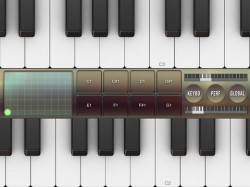 Developer BatZode has released Blowfinger – a breath-controlled instrument for iPad.
Developer BatZode has released Blowfinger – a breath-controlled instrument for iPad.
With Blowfinger, the iPad becomes an expressive, wireless MIDI wind controller, using either keyboard or woodwind technique.
Features:
- Blowfinger can work as a breath controller without sending notes; in Breath-only mode, blow without fingering and it sends a MIDI controller.
- Simultaneous support for Network MIDI over Wi-Fi, hardware MIDI, and inter-application MIDI to control synths running on the same iPad. Also supports rtpMIDI for wireless MIDI on Windows.
- You can personalize the breath response to suit your preference and also to adjust for noisy environments.
- Global transposition.
Blowfinger Keyboard mode:
- Velocity-sensitive keyboard allows you to glide between notes in a way not possible on a regular keyboard
- Use the eight utility pads with user text labels to send program changes or key switches. Or use them to play drums and percussion – they’re velocity-sensitive.
- The XY pad offers additional expressive control in both axes, and it can be set to snap back to zero, to the center, or stay where you release it. Choose which MIDI controller is sent in each direction.
- Transpose octaves up or down with one tap (either or both keyboard manuals).
Blowfinger Wind mode:
- Simplified fingerings based on recorder or Boehm system allow anyone who’s ever played a wind instrument to pick up Blowfinger right away. You switch octaves with your left thumb, so once you know one octave you know them all.
- One size fits all. The keys and the thumb pads can be resized, moved, and stretched all over the screen. Play the instrument on your lap or perhaps a desk in front of you, or move the pads to the sides and hold the iPad up to your belly.
- XY right thumb pad. This has the same features as the one in Keyboard Mode, with your choice of snap back behavior and MIDI controllers.
No audio or video demo is currently available via the developer’s site.
Blowfinger is available in the App Store for US $17.99. See the BatZode site for more info.

This must be brand spanking new. I’m not seeing it in the app store yet.
I think this is a product of Nick Batzdorf. In the last couple years, I’ve seen his name in association with hardware breath control. I think he manufactured a replacement for the BC called Air Command. He is definitely someone who has had his head in the game for a while, so I expect he will have tweaked this to be like a hardware breath-controller.
Playing a woodwind emulator on an iPad screen seems odd, but not impossible. Would love to see video of someone doing it– perhaps playing a woodwind emulator while resting the iPad on your belly is… unflattering?
Seriously though, I tried a couple other breath controlled things on the iPad and wasn’t swept away. Would be cool if someone gets it right. Perhaps this?
Sorry, but I’m just mature enough for an article that features the phrase ‘blow without fingering’, however innocent the context!
Interesting, would like to know if this works or not as asked by stub!
I wonder why iPad though, surely this would make a lot more sense as an iPhone app?
Will be interesting to see it in action. It made me fire up Wivi Band again. I love Wivi band, but I am not a wind instrument player so I just use it for fun. The main issue I see for any breath controller is the positioning of the mic on your iOS device. It’s hard to keep it in the sweet-spot – slightly tilt your device or head and the response alters dramatically. I think a cool solution would be a head mounted mic, so I’m going to try it tonight.
Hey, thanks for the replies. We know we need videos – coming very soon.
Just so you know, this works in three modes: breath-only (no fingering on the iPad – just works like a breath controller); wind – use woodwind fingering on the pad and blow; and keyboard – play notes on the keyboard and blow, sort of like a Melodica.
And yes, it does actually work.
Thanks for chiming in, Nick. Can you talk about the specifics that make this different from how BreathOsc works, for example. Has latency been addressed?
In the iOS world, $18 is nothing to sneeze at (even into a breath controller). Would be good to know more details.
This is the thing a video feedback would be useful, especially at that price.
Something like this has been done before but much more basic, many years ago, I think it was called ocarina or something like that, had it on my iPhone
Why is this app not on the Norwegian App Store? Could you make it available?